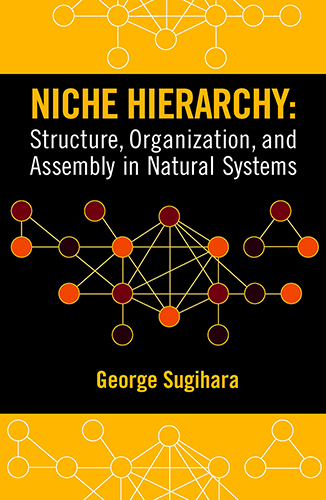Niche Hierarchy: Structure, Organization, and Assembly in Natural Systems
$94.95
Dr. George Sugihara
Hardcover, 6 x 9, 208 pages
ISBN: 978-1-60427-128-7
January 2017
Description
Includes contributions from Robert May (Lord May of Oxford) and Jordi Bascompte
Written by Dr. George Sugihara, this pioneering work represents a unifying synthesis to tie together four disparate areas of ecology: 1) topological structure of food webs; 2) ecosystem dynamics; 3) ecosystem/food web assembly; and 4) universal patterns of species abundance.
Based on the premise that deep general principles are likely to be associated with widely observed empirical regularities, it is organized around uncovering and explaining such patterns for each of the four research areas, and then showing how they interrelate. While this book has historic interest, it is even more relevant today in its findings and overall scope.
Key Features
- Contains one of the earliest food web data atlases
- Shows the development of several novel data-transformation models (transformations of food web matrices) based on graph theory and algebraic topology
- Includes Sugihara’s “Resource Graph”, the “Consumer Overlap Graph”, and the “Simplicial Complex” model of the niche
- Finds that the simplicial complexes of real niche spaces do not have holes but are densely packed
- Shows that chordality (triangulation) is a ubiquitous topological feature of food webs
- Demonstrates the first, and only, empirical ecological assembly rule mathematically deduced from data. The rule involving conservative assembly with an underlying ordering of resources is the basis of current methods for generating model food webs
- Relates the observed topological regularities and the assembly rule to higher dynamic stability in model ecosystems
- Shows how the specific topological features uncovered in food webs resonate with the niche hierarchy model of species abundance – a model with no free parameters that reproduces two universal empirical regularities in ecological species-relative-abundance data (the ubiquitous canonical lognormal species abundance distribution and the species area constant z=1/4)
About the author(s)
George Sugihara is a professor of biological oceanography and a member of the Physical Oceanography Research Division at Scripps Institution of Oceanography, UC San Diego, where he is currently the inaugural holder of the McQuown Chair in Natural Science.
Dr. Sugihara’s research into complex systems and nonlinear forecasting has led to diverse collaborations across academic disciplines as well as with governmental and industrial partners. Part of his current research at Scripps seeks solutions to environmental problems through a combination of scientific and financial market innovations, two areas that reflect his background as a scientist and Managing Director for Deutsche Bank. Sugihara conducts fundamental research on a variety of natural science areas including ecology, neuroscience, gene expression, atmospheric and climate science, and is currently championing a method for addressing Berkeley’s age-old dilemma of detecting causation (versus correlation) in time-series data.
Prior to joining Scripps, Sugihara was concurrently the Wigner Prize Fellow at Oak Ridge National Laboratory and associate professor of Mathematics at the University of Tennessee. He has been a visiting professor at Cornell University, Imperial College London, Kyoto University, and the Tokyo Institute of Technology. He held the UC San Diego John Dove Isaacs Chair at Scripps Oceanography, and was a visiting fellow at Merton College, Oxford University. He is the recipient of several national and international awards, and was a member of the National Academy of Sciences Board on Mathematical Sciences and its Applications, a National Research Council advisory board that advises government agencies, and guides the nation’s mathematics agenda to better serve national needs.
Sugihara received an M.S. in biology and a Ph.D. in mathematical biology, both from Princeton University, where he received the Ogden Porter Jabocbus Prize, Princeton’s highest academic award given by the Graduate School.
Table of Contents
Chapter I
1.1 Introduction
1.2 Menu
Chapter II—Characterizing the Niche
2.1 A Problem of Incompatible Dimensions
2.2 Handling the Dimensionality Problem
2.2.2 The Resource Graph: A Tinker Toy Model
2.2.3 Species as a Convex Polyhedra
2.3 Trophic Equivalence
Summary
Chapter III—Holes in Niche Space
3.1 The Mathematical Structure of Holes
3.1.1 Standard Homology for KC (R; λ-1)
3.1.2 Computing β1 (K) from GC (R; λ-1)
3.2 Homology of Real Food Webs
3.2.1 Results
3.2.2 Statistical Significance of Results
3.2.3 Interpretation of Results
3.3 Robustness: Do Holes Appear Across Variable Thresholds?
3.3.1 Cody’s Community Matrices
3.3.2 Quasi-convexity in the Niche
Summary
Chapter IV—Intervality: Tip of an Iceberg
4.1 Necessary and Sufficient Conditions for Intervality
4.2 Rigid Circuits: A Robust Property of Real Communities
4.4 Assembly Rules Implied by the Rigid Circuit Property in GR(C; λ)
4.5 Assembly and Holes in KC (R; λ-1)
4.6 Assembly and Intervality
Summary
Chapter V—Hierarchical Organization in the Niche
5.1 Structural Hierarchy
5.1.1 Trees: A Characterization of Rigid Circuit Graphs
5.2 Hierarchy in Real Communities
5.3 Functional hierarchy
5.3.1 Compatibility between Structural and Functional Portraits
Summary
Chapter VI—Dynamic Linkages and Topological Patterns
6.1 Triangulation and Stability: A Simple Example
6.2 Triangulation and Stability: Dynamic Selection
6.3 Hierarchy and Stability
6.3.1 Structural Hierarchy
6.3.2Functional Hierarchy
Summary
Chapter VII—Hierarchies of Abundance
7.1 The Niche Hierarchy Model
7.2 Supporting Evidence for Niche Hierarchy
7.2.1 The Geometric Series and Broken Stick Patterns as Special Cases
7.2.2 A Deductive Approach
7.2.3 A Direct Approach
7.2.4 Implications of a Correspondence between Organization and Abundance
7.3 Related Results
7.3.1 Moments of Species Abundance Distributions
7.3.2 Abundance Patterns Implied by Dynamic Models
Summary
Appendix
References
Related products
-

Applied Freshwater Biology
Retail Price: $79.95$69.95 Add to cart -

Head-Related Transfer Function and Virtual Auditory Display
Retail Price: $99.95$89.95 Add to cart -

Building Systems Integration for Enhanced Environmental Performance
Retail Price: $89.95$79.95 Add to cart -

RFID Strategic Implementation and ROI
Retail Price: $49.95$44.95 Add to cart -

Dendroecology
Retail Price: $79.95$69.95 Add to cart

